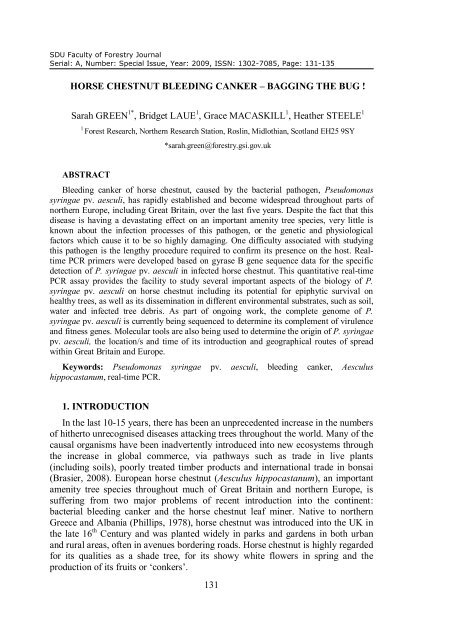sdu faculty of forestry journal special edition 2009 - Orman Fakültesi
sdu faculty of forestry journal special edition 2009 - Orman Fakültesi
sdu faculty of forestry journal special edition 2009 - Orman Fakültesi
You also want an ePaper? Increase the reach of your titles
YUMPU automatically turns print PDFs into web optimized ePapers that Google loves.
SDU Faculty <strong>of</strong> Forestry Journal<br />
Serial: A, Number: Special Issue, Year: <strong>2009</strong>, ISSN: 1302-7085, Page: 131-135<br />
HORSE CHESTNUT BLEEDING CANKER – BAGGING THE BUG !<br />
Sarah GREEN 1* , Bridget LAUE 1 , Grace MACASKILL 1 , Heather STEELE 1<br />
1 Forest Research, Northern Research Station, Roslin, Midlothian, Scotland EH25 9SY<br />
ABSTRACT<br />
*sarah.green@<strong>forestry</strong>.gsi.gov.uk<br />
Bleeding canker <strong>of</strong> horse chestnut, caused by the bacterial pathogen, Pseudomonas<br />
syringae pv. aesculi, has rapidly established and become widespread throughout parts <strong>of</strong><br />
northern Europe, including Great Britain, over the last five years. Despite the fact that this<br />
disease is having a devastating effect on an important amenity tree species, very little is<br />
known about the infection processes <strong>of</strong> this pathogen, or the genetic and physiological<br />
factors which cause it to be so highly damaging. One difficulty associated with studying<br />
this pathogen is the lengthy procedure required to confirm its presence on the host. Realtime<br />
PCR primers were developed based on gyrase B gene sequence data for the specific<br />
detection <strong>of</strong> P. syringae pv. aesculi in infected horse chestnut. This quantitative real-time<br />
PCR assay provides the facility to study several important aspects <strong>of</strong> the biology <strong>of</strong> P.<br />
syringae pv. aesculi on horse chestnut including its potential for epiphytic survival on<br />
healthy trees, as well as its dissemination in different environmental substrates, such as soil,<br />
water and infected tree debris. As part <strong>of</strong> ongoing work, the complete genome <strong>of</strong> P.<br />
syringae pv. aesculi is currently being sequenced to determine its complement <strong>of</strong> virulence<br />
and fitness genes. Molecular tools are also being used to determine the origin <strong>of</strong> P. syringae<br />
pv. aesculi, the location/s and time <strong>of</strong> its introduction and geographical routes <strong>of</strong> spread<br />
within Great Britain and Europe.<br />
Keywords: Pseudomonas syringae pv. aesculi, bleeding canker, Aesculus<br />
hippocastanum, real-time PCR.<br />
1. INTRODUCTION<br />
In the last 10-15 years, there has been an unprecedented increase in the numbers<br />
<strong>of</strong> hitherto unrecognised diseases attacking trees throughout the world. Many <strong>of</strong> the<br />
causal organisms have been inadvertently introduced into new ecosystems through<br />
the increase in global commerce, via pathways such as trade in live plants<br />
(including soils), poorly treated timber products and international trade in bonsai<br />
(Brasier, 2008). European horse chestnut (Aesculus hippocastanum), an important<br />
amenity tree species throughout much <strong>of</strong> Great Britain and northern Europe, is<br />
suffering from two major problems <strong>of</strong> recent introduction into the continent:<br />
bacterial bleeding canker and the horse chestnut leaf miner. Native to northern<br />
Greece and Albania (Phillips, 1978), horse chestnut was introduced into the UK in<br />
the late 16 th Century and was planted widely in parks and gardens in both urban<br />
and rural areas, <strong>of</strong>ten in avenues bordering roads. Horse chestnut is highly regarded<br />
for its qualities as a shade tree, for its showy white flowers in spring and the<br />
production <strong>of</strong> its fruits or ‘conkers’.<br />
131








